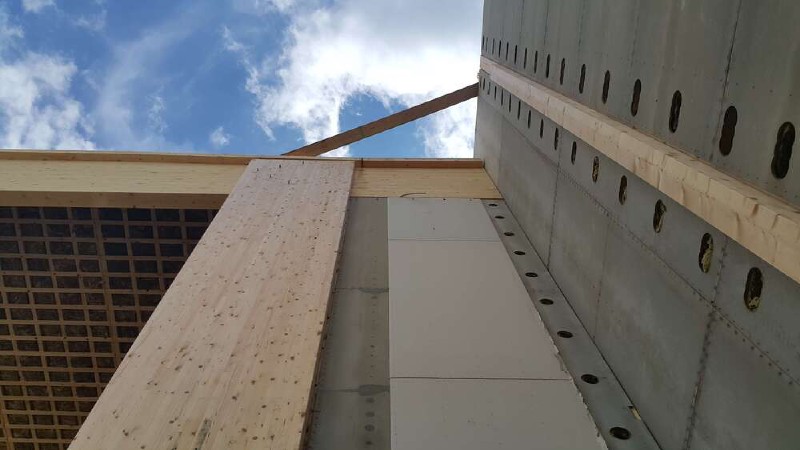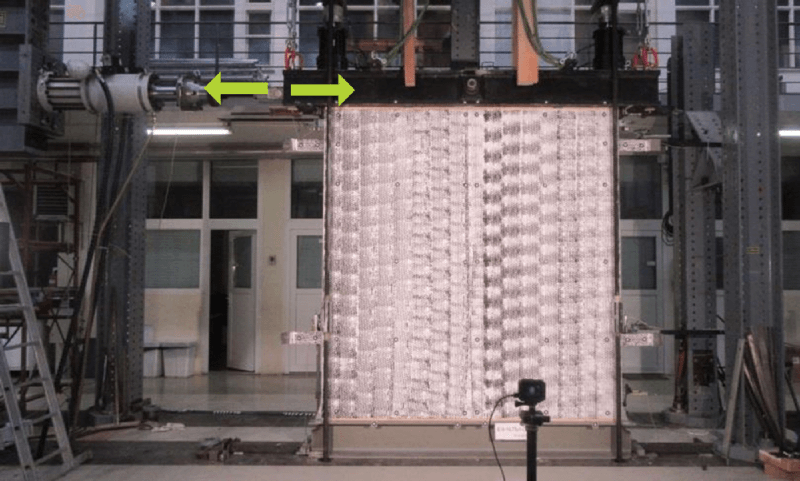Potresna varnost Jelovica hiš potrjena z raziskavo

Že ob potresih leta 1998 in 2004 se je pokazalo, da so montažne hiše Jelovica potres izjemno dobro prestale, saj so jo odnesle brez omembe vrednih poškodb.
Da bi potresno odpornost potrdili tudi strokovno, smo v sodelovanju z Zavodom za gradbeništvo Slovenije (ZAG) opravili obsežno raziskavo in testiranjem obnašanja okvirno-panelnih stenskih elementov s cementno-ivernimi oblogami pri vertikalni in horizontalni obtežbi. Znanstveni prispevek iz raziskav na okvirno-panelnih stenah in rezultati analiz so bili novembra 2020 predstavljeni na Zborovanju gradbenih konstruktorjev na Bledu.
Jelovica cementno iverne plošče že desetletja uporablja kot enega glavnih sestavnih delov svojih konstrukcijskih sistemov. Z uporabo cementno ivernih plošč za izdelavo stenskih elementov ima Jelovica pozitivne izkušnje tako pri izdelavi elementov, njihovi vgradnji v objekte, predvsem pa njihovo dobro obnašanje v celotni življenjski dobi objekta potrjujejo tudi številni uporabniki objektov.
Dokazana vsestranska odličnost cementno iverne plošče
Cementno iverno ploščo odlikuje izredno dobra nosilnost, poleg tega pa še negorljivost, zvočna izolativnost in akumulativnost. Trajno je odporna proti vlagi in nastanku plesni. Brez posledic je lahko dlje časa izpostavljena vremenskim vplivom, medtem ko je potrebno mavčno vlaknene plošče ali OSB zaščititi pred dežjem.
Laboratorijske preiskave nosilnosti stenskih panelov s cementno ivernimi ploščami so potrdile ugoden mehanizem poškodb panelov pri strižnem obremenjevanju in njihovo duktilno obnašanje. Pri strižnem obremenjevanju ne pride do krhke porušitve cementno ivernih plošč, saj plošče minimalno razpokajo le v vogalih. Pri izbiri konstrukcijskih elementov je duktilnost zelo pomembna, saj z njo zagotovimo dodatno varnost pred porušitvijo objekta ob močnejšem potresnem vplivu.

Testiranje stenskega vzorca dejanske velikosti.
Primerjava rezultatov mehanskih testov in analitičnih izračunov so potrdili, da smo s predpostavkami, ki se upoštevajo pri izračunu nosilnosti panelov po veljavnih evropskih predpisih za projektiranje konstrukcij Evrokod, na varni strani.
Montažna lesena hiša Jelovica ima v primerjavi s klasično zidano hišo bistveno manjšo maso, zato so pri potresu vztrajnostne sile na montažno konstrukcijo bistveno nižje. Okvirno-panelne stene, ki so sestavljene iz lesenega okvirja, na katerega so s sponkami pritrjene cementno iverne obloge, dobro prenašajo natezno-tlačne ter strižne sile, ki se pojavijo kot posledica potresa. Duktilni montažni spoji med konstrukcijskimi elementi pa delujejo kot dušilci za sproščanje energije.
Več v strokovnem poročilu Potresna odpornost lesenih hiš Jelovica potrjena z raziskavo.
Leta 2020 smo na svetovni konferenci za leseno gradnjo WCTE2020 predstavili dva prispevka iz omenjene raziskave na okvirno-panelnih stenah. Raziskavo in znanstveni prispevek so pripravili dr. Meta Kržan, dr. Tomaž Palzar, oba ZAG in dr. Boštjan Ber ter Ivan Grašič, oba iz podjetja Jelovica hiše d.o.o.